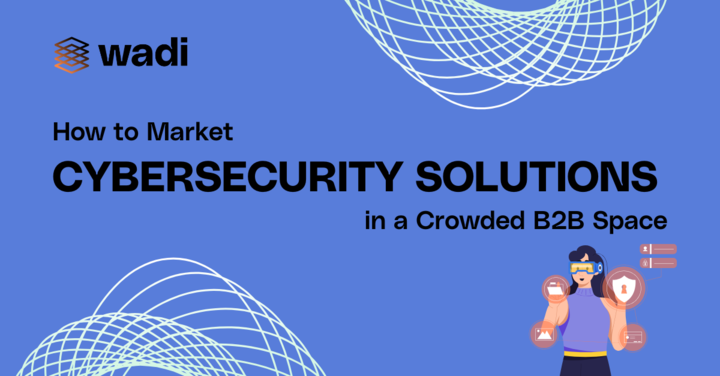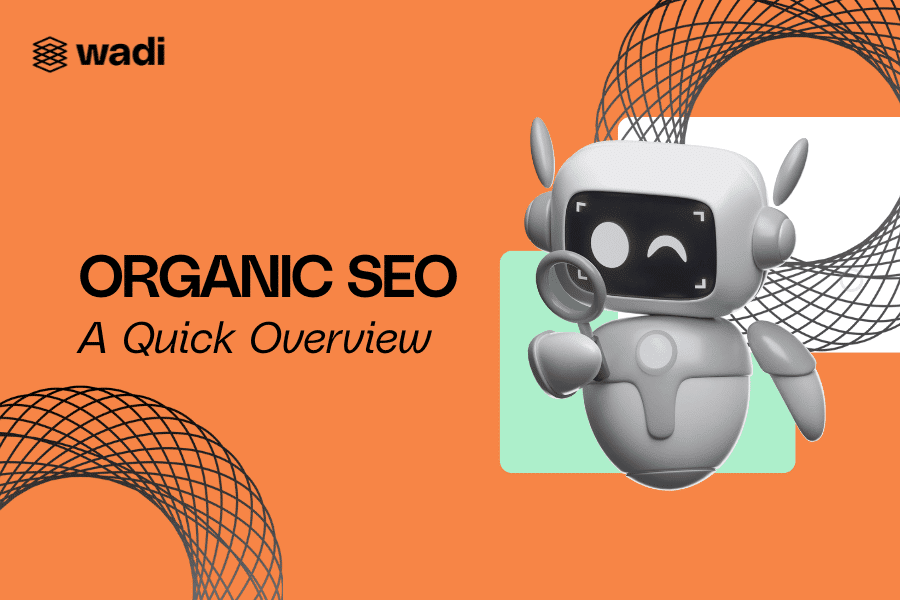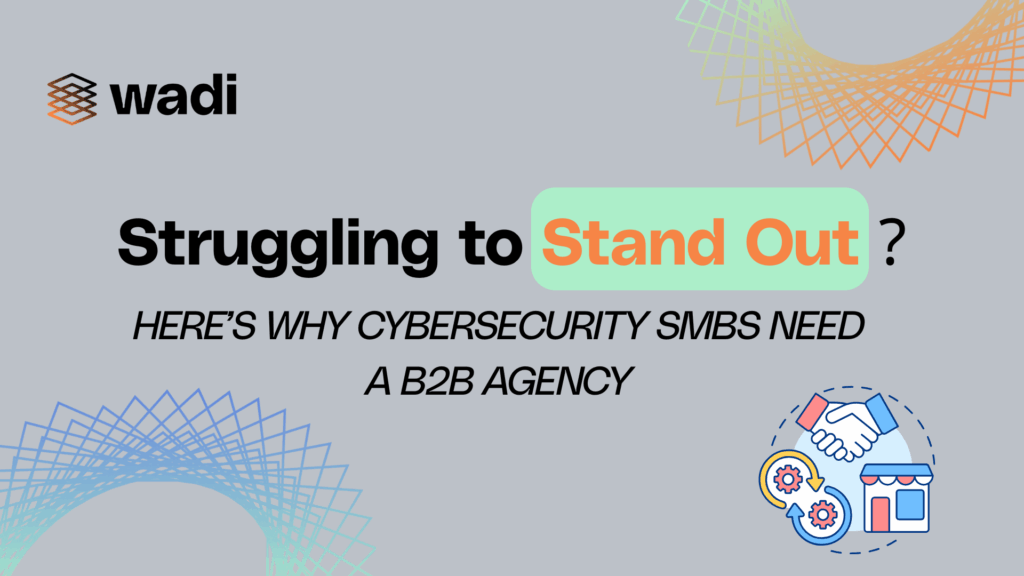Table of Contents
ToggleThe cybersecurity market is rapidly expanding, driven by the increasing need for digital protection against evolving cyber threats. With the global cybersecurity market valued at USD 190.4 billion in 2023 and expected to grow, businesses face intense competition in a crowded space. A strong cybersecurity marketing strategy is essential to stand out, as simply having a good product isn’t enough.
To succeed, companies must craft a marketing approach that resonates with their audience, addresses unique pain points, and builds trust. By focusing on targeted messaging, credibility, and transparent communication, a well-executed cybersecurity marketing strategy can differentiate your brand and capture the attention of potential clients in the competitive B2B cybersecurity market.
What Will You Learn?
- Customizing marketing for CISOs, IT managers, and executives.
- Why a standard approach doesn’t work in cybersecurity.
- Showcasing expertise and credibility.
- Using case studies and testimonials effectively.
- Positioning your brand as a trusted advisor.
Know Your Audience When Building Cybersecurity Marketing Campaigns
Effective cybersecurity marketing hinges on one crucial element: understanding your audience. Cybersecurity professionals, including Chief Information Security Officers (CISOs), IT managers, and executives, have unique needs and priorities when selecting solutions for their organizations. These differences are pivotal in shaping a marketing strategy that resonates with them and leads to success.
How To Understand Your Audience’s Needs?
Each key player in the cybersecurity landscape: CISOs, IT managers, and executives, approaches cybersecurity differently, making it essential to tailor your marketing approach to each.
1. Cisos Primarily Focus On Security.
They are tasked with safeguarding the organization’s infrastructure, systems, and sensitive data. They want to know that the product or service they are considering will mitigate their organization’s risks. Demonstrating your solution’s technical prowess and its ability to prevent, detect, and respond to threats is crucial in gaining their trust.
2. It Managers Prioritize Practicality And Efficiency.
They need solutions that integrate seamlessly with existing systems and offer ease of use. Cost-effectiveness and user-friendliness are paramount for them. Providing case studies that show your solution’s simplicity and ROI can appeal to their need for straightforward, scalable solutions that save time and resources.
3. Executives Look For Peace Of Mind And Cost-Effectiveness.
While they may not be as deeply involved in the technicalities, they are responsible for the company’s financial health and reputation. They want assurance that the cybersecurity solution minimizes risks, prevents costly breaches, and is a sound investment. Framing the cybersecurity solution as an essential tool that protects the company’s bottom line and long-term stability is key when targeting these decision-makers.
By understanding these nuances, your marketing strategy can be aligned with each audience’s unique concerns and needs. Tailoring your content and messaging based on who you’re speaking to ensures better engagement and higher conversion rates.
Why Cybersecurity Needs a Unique Marketing Strategy?
The cybersecurity market is growing rapidly, and with that growth comes increased competition. According to recent reports, the global cybersecurity market was valued at USD 190.4 billion in 2023 and is expected to grow at a CAGR of 9.4% from 2023 to 2028. As more businesses and organizations prioritize securing their digital assets, the need for a well-crafted cybersecurity marketing strategy becomes even more critical.
Cybersecurity solutions are no longer just for large corporations. Small businesses, startups, and even individuals need protection from the increasing volume and complexity of cyber threats. However, the challenge for companies in this space is standing out in a crowded market. Every vendor claims to be the “most secure,” but how can your brand make a difference in such a competitive environment?
A generic marketing approach simply won’t cut it. Cybersecurity is a complex field, and potential customers, whether they’re company decision-makers or security specialists, are looking for clear, credible, and specific solutions. A unique cybersecurity marketing strategy needs to address the specific concerns of each audience while building trust through transparency, expertise, and actionable insights.

Cybersecurity Marketing Strategy Breakdown
When developing a cybersecurity marketing strategy, it’s crucial to focus on several key elements to effectively communicate your brand’s value. Here are some of the main focuses to consider:
1. Building Trust and Credibility
Trust is essential in cybersecurity. Organizations need to feel confident that the solutions they invest in will protect them from cyber threats. To build trust, create educational content that demonstrates your expertise, such as blog posts, whitepapers, webinars, and case studies. Avoid over-the-top claims and instead highlight your solutions’ practical benefits and real-world results.
2. Targeting the Right Audience
Cybersecurity professionals like CISOs and IT managers have different needs and priorities. A one-size-fits-all approach won’t resonate with them. Segment your audience and tailor your messaging to address their unique concerns, security, ease of implementation, or cost-effectiveness. A well-rounded cybersecurity marketing strategy will involve understanding who you’re speaking to and how your solution meets their pain points.
3. Educational Content and Thought Leadership
Since cybersecurity is a rapidly evolving field, your audience will rely on you for up-to-date, actionable information. Establishing thought leadership through well-researched content helps you stay relevant and build credibility. Produce content that educates rather than just sells, providing value through practical insights on current threats, security methodologies, and industry best practices.
4. Social Proof
Buyers in the cybersecurity space are looking for solutions that have proven themselves in real-world situations. Featuring case studies, customer testimonials, and reviews can be a game-changer. It’s not enough to say your solution is effective; you must show it through real examples of how your product or service has solved problems for other businesses. This kind of content helps build Confidence and supports your claims.
Comparing Generic Marketing Strategies & Cybersecurity Marketing Strategies
When applied to the cybersecurity industry, Generic marketing strategies can seem too broad or superficial. Here’s why a cybersecurity marketing strategy needs to be different:
1. Sales Cycle
The sales cycle in cybersecurity is often longer than in many other industries. Decision-makers, such as CISOs and IT managers, must evaluate multiple solutions, consult with various stakeholders, and consider technical and financial factors before purchasing.
This differs from many other industries where decisions are made more quickly. In cybersecurity, you must be patient, providing content that nurtures prospects over time. A typical cybersecurity marketing strategy focuses on building long-term relationships rather than chasing quick conversions.
2. Content
Generic marketing often uses broad content that sometimes lacks depth. However, your content must be highly specialized in cybersecurity, providing in-depth information about your product’s capabilities, security features, and how it handles specific threats. Generic approaches may fail to address the complexity of cybersecurity professionals’ issues.
With a cybersecurity marketing strategy, the content should cater specifically to the industry’s challenges, offering detailed, actionable information that helps customers make informed decisions.
3. Targeted Messaging
Unlike generic strategies that cast a wide net, cybersecurity marketing focuses on segmenting the audience and delivering highly personalized messages. As mentioned, CISOs, IT managers, and executives have different concerns. You can’t speak to all of them in the same way.
For instance, CISOs may care about risk management and compliance, while executives may prioritize ROI and business continuity. Tailoring your messaging for each segment ensures that your communications resonate deeper, leading to better engagement and more qualified leads.
4. Building Trust Through Education and Transparency
While generic marketing strategies may focus on pushing a product, cybersecurity marketing must prioritize education and transparency. Buyers need to understand how a solution works and how it will protect their business.
For example, discussing your product’s compliance with industry standards or explaining how it handles data encryption builds trust and assures the buyer that your solution meets the necessary security requirements. This level of transparency often separates a successful cybersecurity marketing strategy from a generic one.
Build a Cybersecurity Marketing Strategy Your Clients Trust
Trust is everything in cybersecurity. Businesses cannot afford to make mistakes when choosing solutions that protect their most valuable assets, whether sensitive data, infrastructure, or entire networks. They want to be sure that the products or services they invest in will deliver as promised without compromising their security. This is where your cybersecurity marketing strategy needs to shine. Building trust isn’t optional, it’s essential for long-term success.
The Importance of Building Trust Through Real-Life Examples
The world of cybersecurity is complex. It’s filled with technical jargon, evolving threats, and potential risks. So, how can you get your audience to trust your solution? The answer lies in showcasing real-life examples. The more tangible and relatable you make your solution, the more your audience will likely believe in it.
This is where EEAT (Experience, Expertise, authority, and Trustworthiness) plays a critical role. By proving your authority in cybersecurity and showing that your company has the experience and expertise to back up its claims, you gain the trust of your audience.
1. Experience
The more experience you have in cybersecurity, the more credible your brand becomes. Showcase your team’s collective experience through client success stories, detailed case studies, and testimonials. Real examples of how your solution successfully mitigated threats or improved security for businesses help make your offering more credible and relatable.
2. Expertise
Your cybersecurity marketing strategy should demonstrate your team’s expertise. Instead of bombarding your audience with vague claims, showcase your knowledge through blog posts, webinars, whitepapers, and reports explaining emerging threats and how your solution addresses them. Offer insights into industry trends, security challenges, and best practices, which positions your brand as a thought leader.
3. Authoritativeness
Position your company as a leading authority in the cybersecurity field. Highlight certifications, partnerships with recognized security standards organizations, and successful case studies. Clients who see your association with trusted brands feel more confident in your ability to deliver on your promises.
4. Trustworthiness
Finally, trust is built over time. It’s important to show transparency in all your dealings. Ensure your cybersecurity marketing strategy reflects a genuine desire to help, not just sell. Publish reviews, ratings, and third-party assessments to reassure potential clients that others have benefited from your services.
Real-life examples and EEAT not only show that your solution works, but also show that you understand your customers’ pain points and are capable of providing solutions that work for them.
Conclusion
Standing out in a competitive market requires more than offering a reliable product; it demands a well-thought-out marketing strategy that speaks directly to the needs and concerns of your target audience. Tailoring your content and messaging is key, whether you aim to engage CISOs, IT managers, or executives.
By building trust through educational content, real-life case studies, and a transparent approach, you position your company as a trusted advisor in cybersecurity. In a world filled with competition, making your cybersecurity marketing strategy unique, credible, and customer-first will make all the difference in establishing long-lasting relationships and growing your business.
Are you planning your new website? Do you have a qualified SEO company to plan your site migration hand in hand with you? We at WadiDigital, B2B Digital Marketing Agency offer a free SEO review! Don’t miss this amazing opportunity and contact us.
Key Takeaways
- Building trust is the foundation of a successful cybersecurity marketing strategy. Without it, businesses are less likely to invest in your solution, no matter how effective it may be.
- EEAT (Experience, Expertise, authority, and Trustworthiness) is a powerful framework to showcase your credibility in the cybersecurity space.
- Show real-life examples through case studies and testimonials to demonstrate the effectiveness of your solution.
- Transparency and a client-first approach are key to making your marketing trustworthy. Your cybersecurity marketing campaigns should reflect this in every content you produce.
- A strong cybersecurity marketing strategy positions your company not only as a vendor but as a trusted advisor in the cybersecurity field.






